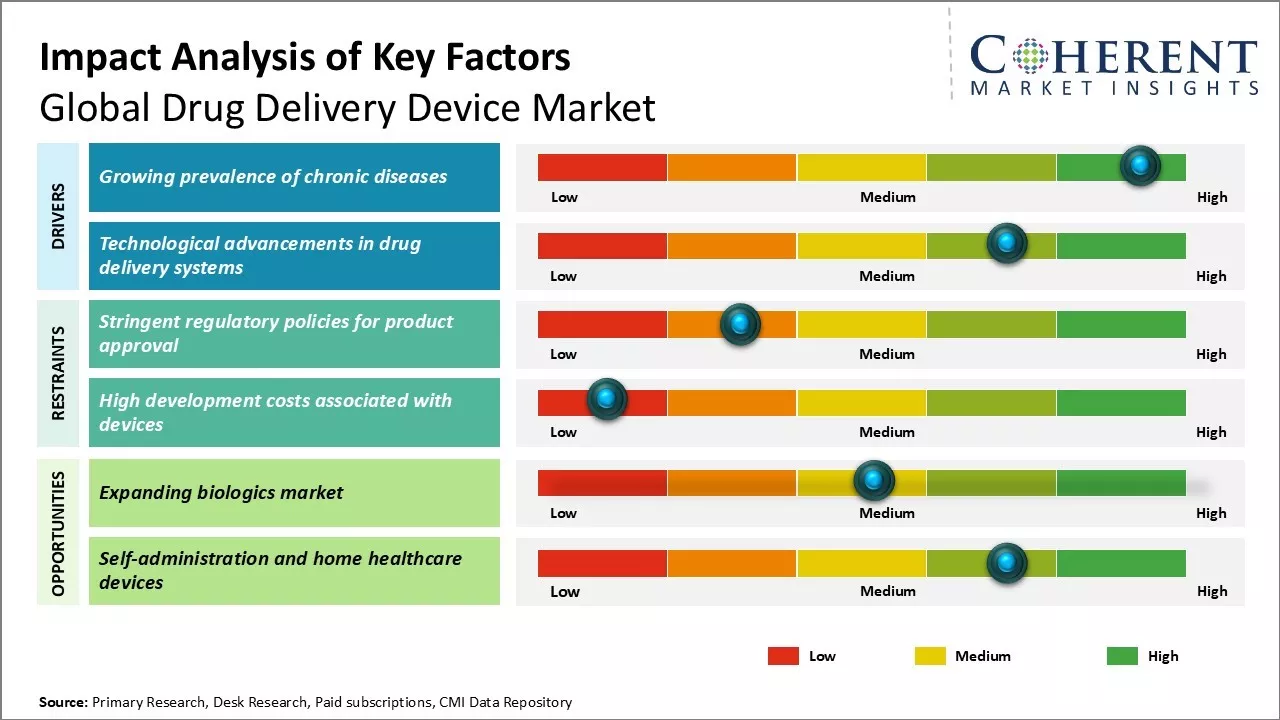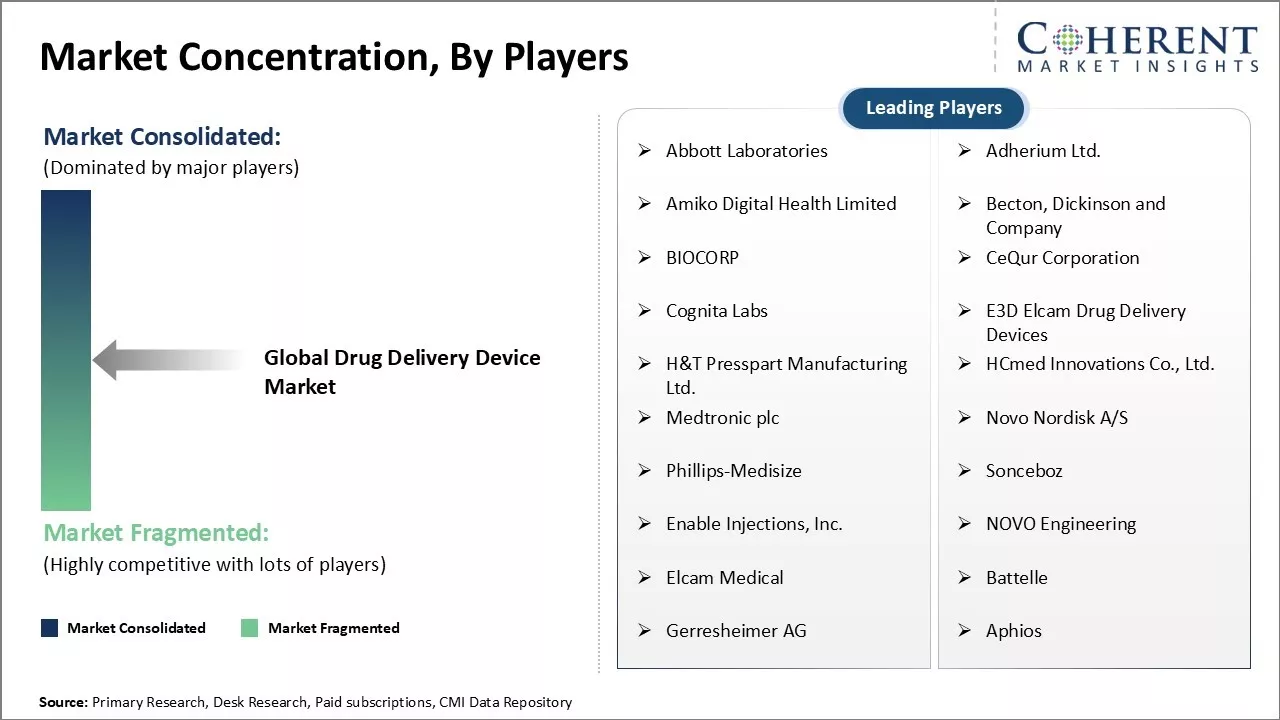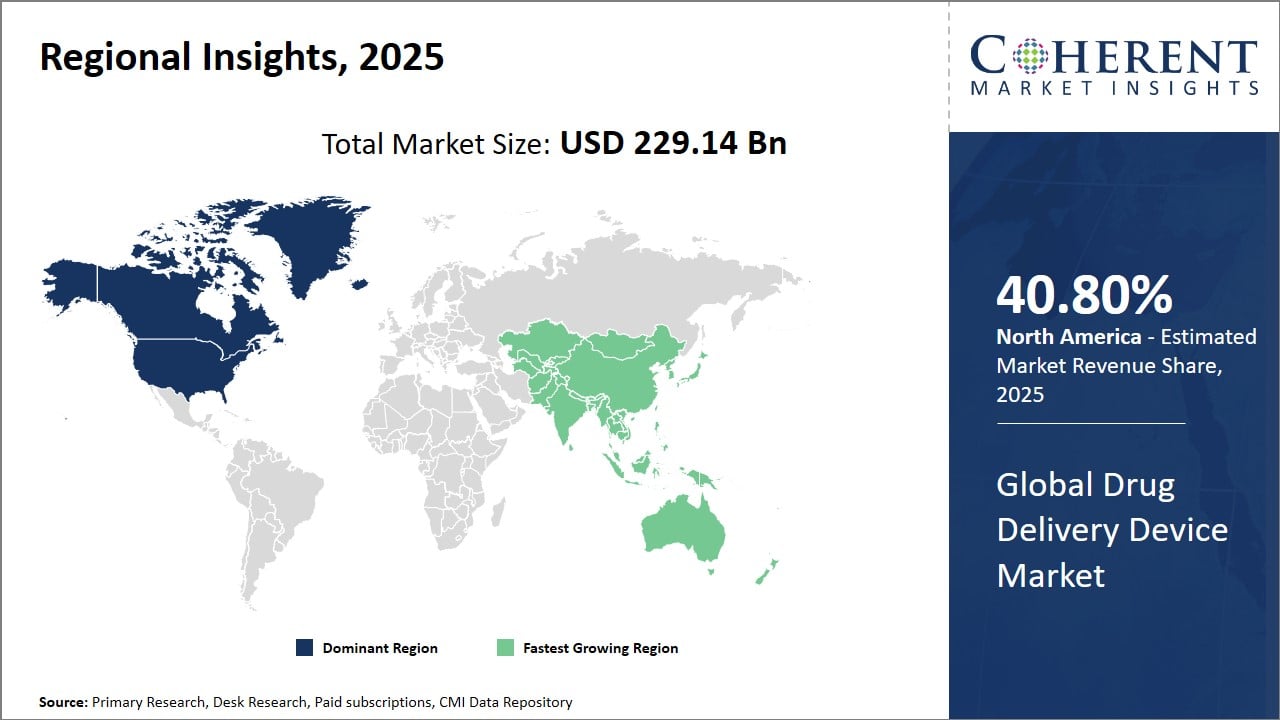Global drug delivery device market is estimated to be valued at USD 229.14 Bn in 2025 and is expected to reach USD 419.14 Bn by 2032, exhibiting a compound annual growth rate (CAGR) of 9.0% from 2025 to 2032.

To learn more about this report, Download Free Sample
The drug delivery device market is experiencing robust growth, driven by rising healthcare needs and technological advancements. Increasing prevalence of chronic diseases, aging populations, and demand for minimally invasive treatments are fueling drug delivery device market demand. Innovations in wearable and automated devices, along with expanding access to healthcare in emerging economies, are accelerating adoption. The market is expected to maintain a steady growth trajectory through 2025, supported by rising healthcare expenditure and continuous R&D in targeted drug delivery systems.
|
Current Event |
Description and its impact |
|
Technological Advancements and Device Innovations |
|
|
Strategic Collaborations and Market Penetration |
|
|
Regulatory Updates and Healthcare Policies |
|
Uncover macros and micros vetted on 75+ parameters: Get instant access to report

To learn more about this report, Download Free Sample
The oncology segment is projected to capture approximately 20.5% of the global drug delivery device market share in 2025. This dominance is driven by the increasing global prevalence of cancer and the growing demand for targeted and minimally invasive treatment options. Drug delivery devices play a crucial role in oncology by enabling parenteral delivery of chemotherapeutic agents, biologics, and immunotherapies with high precision and controlled release.
With the ongoing development of monoclonal antibodies, biosimilars, and personalized medicine, the need for devices that support accurate dosing and patient-specific regimens is rising. Oncology-focused drug delivery systems such as infusion pumps, implantable ports, and smart injectors are being integrated into clinical protocols to improve therapeutic efficacy while minimizing systemic toxicity. As the cancer burden escalates worldwide, this segment is expected to remain a key driver of market growth.
Hospitals are expected to lead the drug delivery device market by end-user category, accounting for 45.5% of the market share in 2025. This trend is primarily fuelled by the increased adoption of advanced drug delivery systems in clinical and inpatient care settings, where patients require specialized treatment and monitoring. Devices such as auto-injectors, infusion systems, and transdermal patches are widely used for delivering precise doses and enhancing treatment adherence.
The hospital environment supports the safe administration of complex therapies, including those used for chronic diseases and post-surgical care. Rising healthcare expenditure, government investments in modernizing medical infrastructure, and a growing focus on improving patient outcomes are encouraging hospitals to incorporate innovative drug delivery technologies. This positions hospitals as the leading end-user segment driving widespread adoption of next-generation devices.

To learn more about this report, Download Free Sample
North America is anticipated to lead the global drug delivery device market in 2025, capturing approximately 40.80% of the total market share. This regional dominance is fuelled by the presence of a strong pharmaceutical and biotechnology ecosystem, advanced healthcare infrastructure, and rapid adoption of innovative drug delivery technologies.
The United States, in particular, is experiencing significant demand for smart, patient-friendly drug delivery solutions, driven by rising healthcare expenditure, an aging population, and increasing prevalence of chronic diseases such as diabetes, cancer, and cardiovascular conditions. From connected inhalers to wearable injectors, U.S. healthcare providers are embracing technology that enhances patient compliance and treatment outcomes.
The region benefits from a favourable regulatory framework, continuous R&D investments, and strategic collaborations between medical device companies, health tech start-ups, and research institutions. These synergies support the development and commercialization of next-generation drug delivery systems, including pain-free drug delivery devices such as transdermal patches, implantable pumps, and auto-injectors that minimize patient discomfort while maintaining therapeutic efficiency.
As digital health integration accelerates and personalized medicine gains momentum, North America is expected to sustain its leadership in the drug delivery device market through 2025 and beyond, setting global benchmarks for innovation and accessibility.
The United States leads the global drug delivery device market, significantly contributing to North America’s projected 40.8% market share in 2025. Its leadership is driven by a mature pharmaceutical industry, rapid integration of smart healthcare technologies, and strong demand for patient-centric drug delivery solutions.
High prevalence of chronic conditions such as cancer, diabetes, and respiratory disorders has led to the widespread use of advanced devices like auto-injectors, wearable insulin pumps, and connected inhalers. U.S. healthcare providers are actively adopting these technologies to enhance treatment precision and patient adherence.
The presence of leading pharmaceutical and medtech firms, along with favourable FDA regulations and continuous R&D investment, reinforces the country's dominance. Strategic partnerships between tech companies and healthcare providers are further accelerating the development and deployment of innovative drug delivery platforms across clinical and home-care settings.
Canada plays a vital role in the North American drug delivery device market, benefiting from its advanced healthcare infrastructure, government support for innovation, and increasing focus on chronic disease management.
Canadian healthcare institutions are adopting smart and minimally invasive drug delivery solutions, particularly in oncology, diabetes care, and geriatric medicine. The rise in home-based care services has further fuelled demand for easy-to-use devices such as prefilled syringes, transdermal patches, and connected devices.
With public health agencies encouraging digital health integration and regulatory bodies ensuring high product safety standards, Canada continues to make significant contributions to regional and global drug delivery innovations. Public-private collaborations are also promoting scalable R&D efforts and improved patient outcomes.
| Report Coverage | Details | ||
|---|---|---|---|
| Base Year: | 2024 | Market Size in 2025: | USD 229.14 Bn |
| Historical Data for: | 2020 To 2024 | Forecast Period: | 2025 To 2032 |
| Forecast Period 2025 to 2032 CAGR: | 9.0% | 2032 Value Projection: | USD 419.14 Bn |
| Geographies covered: |
|
||
| Segments covered: |
|
||
| Companies covered: |
Abbott Laboratories, Adherium Ltd., Amiko Digital Health Limited, Becton, Dickinson and Company, BIOCORP, CeQur Corporation, Cognita Labs, E3D Elcam Drug Delivery Devices, H&T Presspart Manufacturing Ltd., HCmed Innovations Co., Ltd., Medtronic plc, Novo Nordisk A/S, Phillips-Medisize, Sonceboz, Enable Injections, Inc., NOVO Engineering, Elcam Medical, Battelle, Gerresheimer AG, Aphios |
||
| Growth Drivers: |
|
||
| Restraints & Challenges: |
|
||
Uncover macros and micros vetted on 75+ parameters: Get instant access to report
Growing prevalence of chronic diseases across the globe has boosted demand for advanced drug delivery devices. Chronic diseases such as diabetes, cardiovascular diseases, respiratory diseases and others require long term medical treatment and management.
These diseases are often associated with side effects of drugs used for treatment, which can be minimized through effective drug delivery methods. Advanced drug delivery devices offer a controlled and targeted delivery of drugs, which helps patients to manage chronic conditions efficiently.
Many developed nations have witnessed substantial rise in life expectancy and aging population is more prone to chronic health issues. Developing countries are also witnessing epidemiological transition where infectious diseases are declining and non-communicable chronic diseases are increasing. This can be attributed to changes in lifestyle and environmental factors.
Growing patient pool of chronic diseases worldwide has created an enormous market for innovative drug delivery devices. Companies are investing heavily in R&D to develop devices providing sustained release, minimal drug degradation and improved patient compliance. Wearable and portable delivery devices are gaining popularity for their convenience in administering drugs effectively without major lifestyle alterations.
Rising cases of diabetes can also drive the market growth. As per WHO, over 460 million people suffered with diabetes. Advanced insulin pens, pumps and inhalable formulations are revolutionizing diabetes management. Respiratory diseases also contribute significantly with over 300 million people suffering from asthma. Inhalers and nebulizers offering controlled medication delivery directly to lungs witness huge demand.
Rapid pace of innovation in drug delivery technologies has substantially expanded the capabilities and applications of devices. Advanced materials, miniaturization of components and digital integration boosts new product development. Micro needle patches provide painless intradermal access for vaccines and other drugs.
Printed electronic skins enable controlled release of drugs through flexible polymer matrices. Implantable drug delivery systems using microchips and microtubules ensure precise long-term dosing for conditions like contraception or Parkinson's disease. Wearables integrated with sensors and wireless connectivity allow automated monitoring and administration based on patient’s physiological needs.
3D printing revolutionizes the manufacturing of customized drug delivery solutions. Complex custom shapes required for sustained release formulations or targeted organ/tissue applications can now be precisely produced. It also offers possibilities for on-demand printing of devices. This reduces supply chain issues and production time. Integration of artificial intelligence and machine learning enable smarter devices.
Pattern recognition of symptoms, predictive analysis of medication needs and automated device adjustments based on algorithms improve therapeutic outcomes. Miniaturization of electronics has facilitated development of micro needles and ingestible sensors within size limitations required for patient comfort.
Expanding biologics market can offer growth opportunities for global drug delivery device market. Biologics such as monoclonal antibodies and recombinant proteins have revolutionized the treatment of complex diseases like cancer and rare genetic disorders.
Biologics often require parenteral delivery such as injections owing to their structural complexity. These boosts demand for prefilled syringes, auto-injectors, drug reconstitution devices and wearable drug delivery systems. It is projected that biologics will account for over 50% of the pharmaceutical market by 2030.
As more biologics receive regulatory approvals and enter clinical use, it will spur the development of advanced devices that can administer these drugs in user-friendly formats. Rising biologics offers scope for innovation across secondary packaging, delivery modalities and connectivity in drug delivery devices. Many existing as well as emerging players are strategically focusing on this vertical for future growth opportunities.
Share
Share
About Author
Manisha Vibhute is a consultant with over 5 years of experience in market research and consulting. With a strong understanding of market dynamics, Manisha assists clients in developing effective market access strategies. She helps medical device companies navigate pricing, reimbursement, and regulatory pathways to ensure successful product launches.
Missing comfort of reading report in your local language? Find your preferred language :
Transform your Strategy with Exclusive Trending Reports :
Frequently Asked Questions
Joining thousands of companies around the world committed to making the Excellent Business Solutions.
View All Our Clients